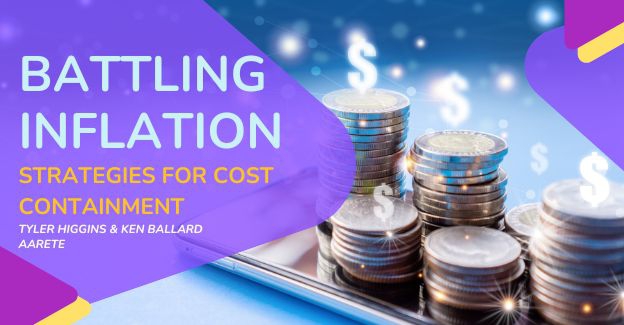Procurement professionals across the globe are being catapulted to the front lines of the battle for cost-containment, remaining competitive in their respective industries, and in some cases saving operations from going under, says AArete's Ken Ballard and Tyler Higgins. They share some of the factors at play, including strategies to combat inflation and mitigate risks.
Supply chain and procurement professionals are now tasked with the near-impossible: fighting off upstream price increases and obtaining year-over-year cost savings in today’s inflationary environment. For the first time in years, suppliers are in control and cost savings are hard to find. Where does one start? Are cost savings even possible in today’s world? Is cost avoidance the only hope moving forward?
The Current State of Inflation
With inflation rising 0.6% in March, this has brought the annual inflation rate to 8.5%, which is the highest rate seen since 1981. The global supply chain challenges we face today are dynamic and complex in nature but can boiled down to the simple concept of supply and demand. We are in a macro-economic environment where demand is far outweighing supply in almost all markets. With the recent geo-political conflict in the Ukraine, this has only worsened an already strained global supply chain as both countries’ exports have been impacted. We are experiencing a perfect storm, and prices in all industries will continue to rise putting the top priority for all industries at containing costs.
It may be obvious, but why are costs up?
Demand-Side Factors:
- Government fiscal stimulus; increase in consumer savings and purchasing power
- Pent-up demand created from 2020 and 2021 lockdowns
- Consumer propensity shift to buy goods versus services due to COVID restrictions
Supply-Side Factors:
- Labor shortages fueled by unprecedented unemployment benefits, the great resignation and accelerated baby-boomer retirement rates
- Ongoing factory shutdowns due to inability to contain COVID outbreaks and China’s “Zero COVID” policies
- Port delays due to inability to scale up operations because of labor and infrastructure challenges in the trucking, warehousing, and logistics industries
- China energy shortage resulting from ongoing energy policy compliance efforts, an increase in demand for Chinese goods and production slowdowns
- U.S. and NATO import ban on various Russian supplied commodities straining the supply of fossil fuels, iron, steel, aluminum, fertilizers, wood and other materials in the global market
- Ukraine export limitations caused by the Russian invasion impacting the availability in the global supply chain for iron, steel, sunflower oil (largest producer in the world) and wheat exports
Battling Inflation
The Fed continues to fight inflation by lifting interest rates and most recently raising the federal funds rate by 25 basis points as of mid-March with six more increases scheduled by year end. To put this into perspective, this is the most aggressive the Fed has manipulated interest rates in over 15 years. These efforts should slow inflation, however in the short-term, supply markets around the world, particularly commodity markets, will continue to put upward price pressure on all goods and services.
Retailers and manufacturers are not able to pass on cost increases to customers at the same rate inflation is rising due to the dynamic nature of cost increases and the sensitivity of consumers to take such drastic price increases. It is a delicate balance between supply and demand. Retailers and manufacturers are experiencing significant margin degradation due to both direct and SG&A costs rising and the inability to fully pass through to consumers.
Procurement Strategy
As a procurement professional, now more than ever, you have more influence over margins and the ability of your company to maintain financial stability as we move further into an inflationary global economy. Your understanding of your operation’s exposure to commoditized price variance is of the upmost importance, along with deploying both proactive and reactive cost containment strategies.
- First Step - Risk Assessment: Conduct a spend analysis and highlight areas most closely tied to commodity pricing to understand your exposure. Some common examples which stand out for retailers and manufacturers by spend category/sub-category:
- Logistics – LTL, TL, Fuel, Air freight, Warehousing, Trucks and Fleet Vehicles
- Utilities – Electricity, Natural Gas
- Packaging – Corrugate, Pallets, Stretch Wrap
- Administrative Expenses - Office Supplies, Temporary Labor, Office Machines
- MRO – Industrial Supplies, PPE, Electrical Supplies
- Direct Materials – Agricultural Materials, Plastics, Sheet Metal, Chemicals and Resins
Mitigation Strategies
There are reactive and proactive strategies which procurement professionals can deploy to mitigate upstream price increases. Though proactive strategies are most optimal to deploy, today’s global supply chain markets are fast moving and hard to predict, especially considering geo-political factors.
-
Reactive Strategies:
- Cost Build-Up Approach – Develop a formula to audit cost increases and ensure costs are being passed through and not being used to pad upstream supplier margins. This can be achieved by breaking the cost of a good or service into its many parts, applying factored increases to affected segments and building up a “should be” cost model.
- Conduct Market Analysis and Leverage Benchmark Data – Via internal means or externally via third party, aggregate and leverage competitive market data to understand the cost basis and negotiate against cost increases.
- Focus on Long-Term Relationships With Suppliers – Negotiate for sharing in cost increases, just as you are with your end customers as a retailer, for example.
- Bring Category to Market – Test the market via RFQ to identify if alternate suppliers are willing and able to control costs better than your current supplier(s).
- Leverage Economies of Scale – Brainstorm and leverage possible growth opportunities with the supplier(s) to offset proposed increases.
-
Proactive Strategies:
- Category Management – Ensure proper coverage of goods or services that are critical to operations by having a bench of suppliers under contract to promote cost competition within the spend category while ensuring optimal supply is available during times of market volatility.
- Creative Cost Containment Strategies – Evaluate opportunities to change consumption patterns or demand patterns to offset cost increases. Through an exhaustive review of your operation and a strong partnership with business stakeholders, organizations can find opportunities to change long-standing consumption patterns allowing bottom line impact despite rising costs.
- Contractual Cost Controls – Negotiate robust cost control language into your MSA and SOWs:
- Cap annual cost increases
- Require documentation to accompany any notice of increase such as manufacturer letters of cost increase, indices backup and/or letters from the supplier executive team
- Require 30 to 60 days written notice before increases can take effect
- Requiring mutual agreement to increases in writing to allow for a negotiation period
- Agree to and implement a cost increase formula with the supplier during the contracting process using the cost build-up approach
- Lock in pricing for full contract term – though this typically impacts the pricing offered as suppliers will bake risk into the contract pricing up-front
- Strategic Contract Incentives – negotiate a tiered rebate schedule based on annual spend to both offset the impact of future cost increases and provide a reward system for expansion of the partnership
- Hedging – Lock in futures pricing for key commodity inputs to your final good or service to reduce volatility and potentially capitalize on spot market variance
- Evaluate Substitute Products – Partner with your supplier-partners to have lower cost, substitute products or services vetted, available and ready to operationally deploy
There is no magic bullet for navigating this inflationary and disruptive period in the global economy. However, as procurement professionals you can deploy various best practices to help your organization weather this storm.
Starting with a risk analysis and followed with proactive and reactive strategies and tactics, you can predict, control and mitigate cost increases to secure a competitive advantage in your respective industry. The current landscape is positioning procurement to rise to the challenge and become key leaders in cost containment for your organization.










